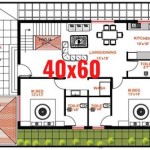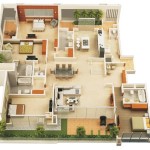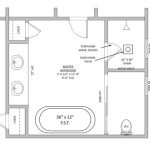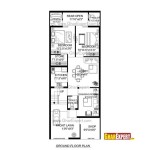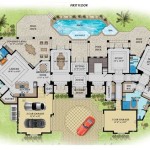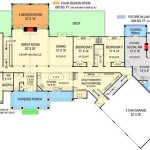House Plans for 300 Square Feet: Maximizing Minimal Spaces
Designing a house within a mere 300 square feet presents a significant challenge, demanding meticulous planning and innovative solutions. This compact footprint necessitates a strategic approach that prioritizes functionality, space optimization, and efficient use of every available inch. Successful 300 square foot house plans transform what might seem like a limitation into an opportunity to create a comfortable, livable, and aesthetically pleasing dwelling.
The rise of tiny homes and minimalist living has fueled interest in these small-scale designs. Individuals looking to downsize, simplify their lives, or create affordable housing options are increasingly drawn to the possibilities offered by small square footage. This article will explore crucial considerations and strategies for designing effective house plans for 300 square feet, focusing on key areas such as space utilization, layout design, storage solutions, and material selection.
Prioritizing Functionality and Essential Features
In a 300 square foot house plan, every square foot must serve a purpose. Prioritizing essential functions and carefully selecting amenities that support those functions is paramount. A successful design cannot afford to include underutilized spaces or purely decorative elements that consume precious square footage. The floor plan must seamlessly integrate living, sleeping, cooking, and bathing areas, often through multi-functional design elements.
Consider the essential activities that will take place within the home. These activities will dictate the core requirements for each zone. For example, if the occupant enjoys cooking frequently, the kitchen area will need to be more robustly equipped than if only minimal food preparation is required. Similarly, if the occupant works from home, a dedicated workspace, even if small, becomes a necessity.
Flexibility is key. Furniture should be chosen or designed to serve multiple purposes. A sofa bed can provide seating during the day and transform into a bed at night. A dining table can double as a workspace. Fold-down or pull-out furniture can be concealed when not in use, freeing up valuable floor space. The focus should be on adaptable spaces that cater to various needs throughout the day.
Vertical space should also be considered. Utilizing the full height of the room can significantly increase storage capacity and create a sense of spaciousness. Lofted beds, high shelving, and wall-mounted storage units are all effective strategies for maximizing vertical space. Careful planning and thoughtful design are essential to create a functional and comfortable living environment within the limited confines of 300 square feet.
Optimizing Layout and Spatial Arrangements
Efficient layout design is critical when planning a 300 square foot home. The configuration of rooms and the flow of traffic through the space directly impact livability and perceived spaciousness. Open floor plans are generally favored for small spaces, as they eliminate unnecessary walls and create a more fluid transition between living areas. However, strategic zoning within the open plan is important to define individual functional areas and maintain a sense of order.
Careful consideration should be given to the placement of essential fixtures and appliances. Compact appliances, such as apartment-sized refrigerators and combination washer-dryers, are often necessary to conserve space. Choosing appliances with a smaller footprint without sacrificing functionality is vital. The arrangement of these elements should optimize workflow and minimize wasted space within the kitchen and bathroom areas.
Strategic use of natural light can significantly enhance the feeling of spaciousness in a small home. Maximizing window size and placement will allow natural light to penetrate deep into the interior, making the space feel brighter and more expansive. Skylights can also be an effective way to introduce natural light, particularly in areas where wall windows are not feasible. The orientation of the house on the building site should be considered to maximize solar gain and minimize energy consumption.
Circulation paths should be streamlined to avoid congestion and wasted space. Hallways should be minimized or eliminated, and furniture should be arranged to allow for easy movement throughout the home. The layout should prioritize a clear and intuitive flow, making it easy to navigate the space and access essential amenities. This thoughtful approach to layout design can significantly improve the livability of a small home.
Implementing Clever Storage Solutions
Storage is a major challenge in any small home, and a 300 square foot house requires particularly innovative solutions. Building storage into every available nook and cranny is crucial for maintaining a clutter-free and organized living environment. The goal is to maximize storage capacity without sacrificing valuable floor space or compromising the aesthetic appeal of the home.
Built-in storage is often the most effective option in small spaces. Custom-designed cabinetry can be tailored to fit specific needs and utilize every inch of available space. Consider incorporating storage into benches, stairs, and even under the bed. This type of integrated storage can be seamlessly incorporated into the architecture of the home, creating a clean and uncluttered look.
Vertical storage is another key strategy. Tall, narrow shelves can provide ample storage without taking up too much floor space. Wall-mounted storage units, such as shelves and cabinets, can free up floor space and create a more open feel. Hooks and hangers can be used to organize clothing, tools, and other items, keeping them off the floor and within easy reach.
Multi-functional furniture can also contribute to storage solutions. Ottoman storage, benches with built-in storage compartments, and coffee tables with drawers or shelves can provide discreet storage options without sacrificing functionality. Choosing furniture that serves multiple purposes can help to minimize clutter and maximize the use of available space.
Finally, consider off-site storage options for items that are not used frequently. Renting a small storage unit or utilizing attic or basement space (if available) can free up valuable space within the home. By implementing a combination of built-in storage, vertical storage, multi-functional furniture, and off-site storage, it is possible to create a well-organized and clutter-free living environment within a 300 square foot house.
The choice of materials and finishes can also impact the perceived spaciousness of a small home. Light colors tend to make a space feel larger and brighter, while dark colors can make it seem smaller and more cramped. The use of mirrors can also create the illusion of more space by reflecting light and visually expanding the room. Streamlined finishes and avoiding excessive ornamentation contribute to a clean and uncluttered aesthetic.
In conclusion, designing house plans for 300 square feet requires a thoughtful and strategic approach. By prioritizing functionality, optimizing layout, implementing clever storage solutions, and carefully selecting materials and finishes, it is possible to create a comfortable, livable, and aesthetically pleasing home within a very small footprint. The key is to make every square foot count and to embrace the principles of minimalist living.

Cottage Style House Plan 2 Beds 1 Baths 300 Sq Ft 423 45 Houseplans Com

15x20 House Plan Design 300 Sq Ft 15 20 By

300 Sqft Small Village House Ii 12 X 25 Ghar Ka Naksha Home Design

Cottage Style House Plan 1 Beds Baths 416 Sq Ft 514 2

Modern Home Plan 1 Bedrms Baths 300 Sq Ft 211 1013

Farmhouse Plan 300 Square Feet 1 Bathroom 035 00968

10x30 Feet 300 Sqft Tiny House Design Small Ideas Plan Id 079

300 Square Foot House Plans

4 Inspiring Home Designs Under 300 Square Feet With Floor Plans

300 Sqft 15x20 House Plan With 3d Elevation By Nikshail

